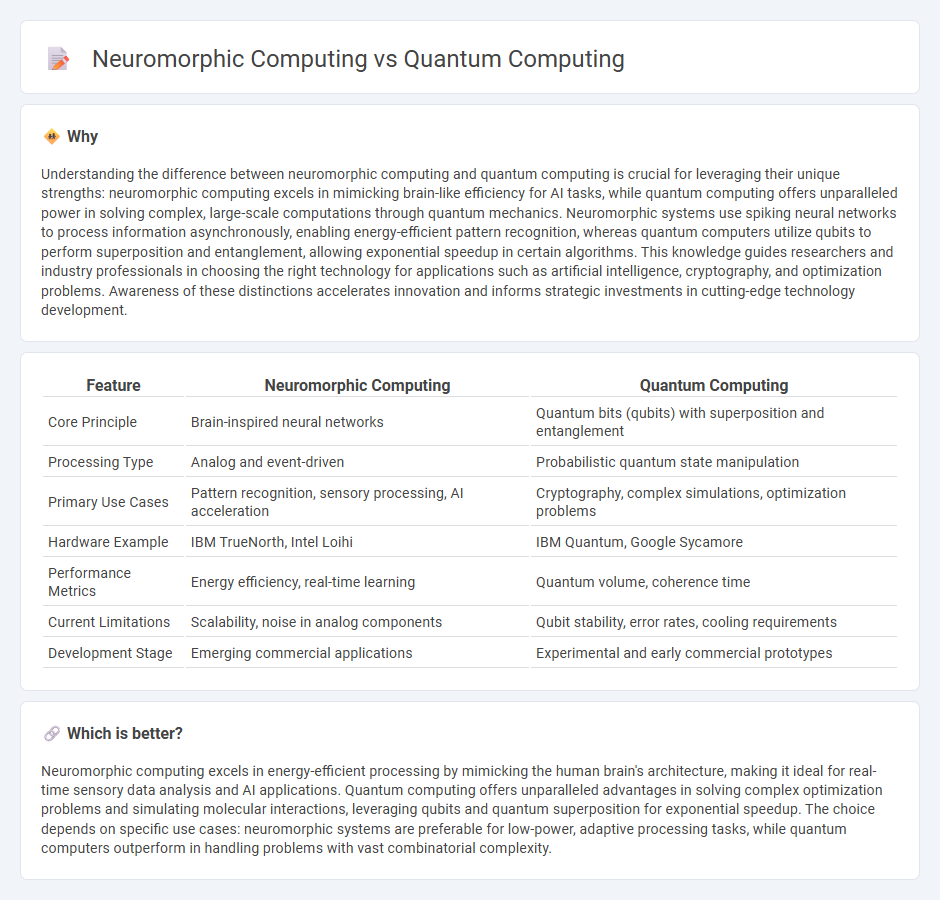
Neuromorphic computing mimics the brain's neural architecture to improve energy efficiency and parallel processing, while quantum computing leverages quantum mechanics to solve complex problems beyond classical capabilities. Both technologies aim to revolutionize computing power, with neuromorphic excelling in pattern recognition and quantum excelling in optimization and cryptography. Explore the distinct advantages and future potential of neuromorphic and quantum computing in advancing technological innovation.
Why it is important
Understanding the difference between neuromorphic computing and quantum computing is crucial for leveraging their unique strengths: neuromorphic computing excels in mimicking brain-like efficiency for AI tasks, while quantum computing offers unparalleled power in solving complex, large-scale computations through quantum mechanics. Neuromorphic systems use spiking neural networks to process information asynchronously, enabling energy-efficient pattern recognition, whereas quantum computers utilize qubits to perform superposition and entanglement, allowing exponential speedup in certain algorithms. This knowledge guides researchers and industry professionals in choosing the right technology for applications such as artificial intelligence, cryptography, and optimization problems. Awareness of these distinctions accelerates innovation and informs strategic investments in cutting-edge technology development.
Comparison Table
| Feature | Neuromorphic Computing | Quantum Computing |
|---|---|---|
| Core Principle | Brain-inspired neural networks | Quantum bits (qubits) with superposition and entanglement |
| Processing Type | Analog and event-driven | Probabilistic quantum state manipulation |
| Primary Use Cases | Pattern recognition, sensory processing, AI acceleration | Cryptography, complex simulations, optimization problems |
| Hardware Example | IBM TrueNorth, Intel Loihi | IBM Quantum, Google Sycamore |
| Performance Metrics | Energy efficiency, real-time learning | Quantum volume, coherence time |
| Current Limitations | Scalability, noise in analog components | Qubit stability, error rates, cooling requirements |
| Development Stage | Emerging commercial applications | Experimental and early commercial prototypes |
Which is better?
Neuromorphic computing excels in energy-efficient processing by mimicking the human brain's architecture, making it ideal for real-time sensory data analysis and AI applications. Quantum computing offers unparalleled advantages in solving complex optimization problems and simulating molecular interactions, leveraging qubits and quantum superposition for exponential speedup. The choice depends on specific use cases: neuromorphic systems are preferable for low-power, adaptive processing tasks, while quantum computers outperform in handling problems with vast combinatorial complexity.
Connection
Neuromorphic computing and quantum computing both aim to revolutionize information processing by mimicking natural systems and leveraging principles of quantum mechanics, respectively. Neuromorphic computing uses brain-inspired architectures to enable energy-efficient, parallel data processing, while quantum computing exploits superposition and entanglement to solve complex problems beyond classical computers. Integrating neuromorphic algorithms with quantum hardware could enhance computational speed and adaptability in artificial intelligence applications.
Key Terms
Qubits
Quantum computing utilizes qubits, which leverage superposition and entanglement to process vast amounts of data simultaneously, enabling exponential speedups for specific problems. Neuromorphic computing, inspired by the brain's architecture, employs spiking neural networks and memristors to mimic neural synapses but does not use qubits or quantum states. Explore how these distinct approaches impact computational capabilities and innovation by delving deeper into their qubit-based mechanisms.
Spiking Neural Networks
Quantum computing leverages qubits and superposition to perform complex calculations exponentially faster than classical computers, while neuromorphic computing mimics the brain's neuronal architecture using Spiking Neural Networks (SNNs) to achieve energy-efficient and real-time processing. SNNs model the timing and dynamics of biological neurons, enabling hardware implementations that excel in pattern recognition, sensory processing, and adaptive learning tasks. Explore the evolving roles of quantum and neuromorphic systems in advanced AI by learning more about their unique computational paradigms.
Superposition
Quantum computing leverages the principle of superposition, allowing qubits to exist in multiple states simultaneously, vastly increasing computational power for complex problems like factorization and optimization. Neuromorphic computing, inspired by the brain's neural architecture, does not inherently use superposition but excels in parallel processing and energy efficiency for tasks such as pattern recognition. Explore the distinct advantages and applications of superposition in quantum computing and how it contrasts with neuromorphic approaches by learning more.
Source and External Links
DOE Explains...Quantum Computing - This webpage provides an overview of quantum computing, highlighting its potential to solve complex problems through the use of qubits and quantum mechanics.
What is quantum computing? - This article explains quantum computing by contrasting it with classical computing, focusing on qubits, superposition, and entanglement.
What Is Quantum Computing? - This IBM webpage discusses quantum computing as a technology that harnesses quantum mechanics to solve complex problems beyond the capabilities of classical computers.
 dowidth.com
dowidth.com